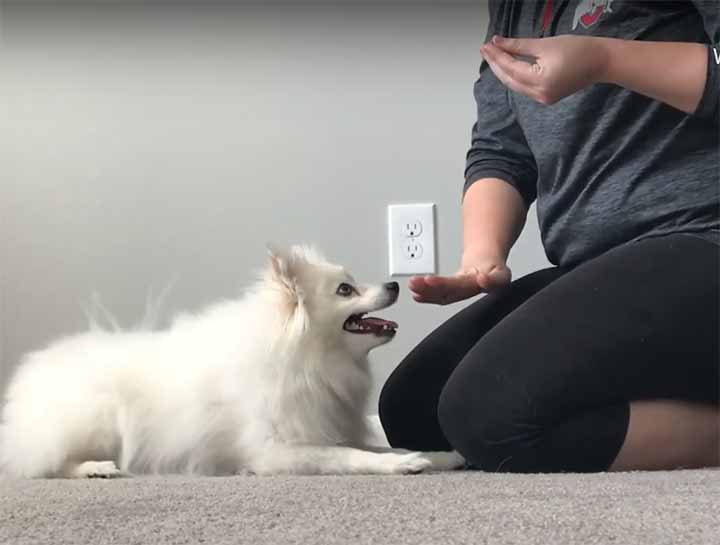Training Tips for Deaf or Deaf and Blind Dogs

Training is an important part of any dog’s life. It’s about more than teaching your dog to behave better—it provides mental stimulation, helps him be more relaxed and confident in social situations, and strengthens the bond the two of you share. But best of all, it’s fun!
If your dog is deaf or deaf and blind, you’ll need to make some adjustments, but the training can still be very rewarding. Set realistic expectations and be patient!
Here are some helpful tips if you live with a deaf or deaf and blind dog.
- Sleeping deaf dogs can easily startle, so wake them carefully by gently tugging on the edge of their blankets.
- Always have your dog leashed when you’re in an unfenced area, because he cannot hear cars or other dogs.
- Add a line on your dog’s tag saying he is deaf or deaf and blind.
- Let your dog know when you’re leaving the house so he won’t search for you.
- Crate train your dog so he will be safe when you aren’t home.
- Attach a bell to your dog’s collar so you will always know where he is.
- Never change the location of a blind dog’s food, water and bed.
- Don’t rearrange your furniture because that can be unsettling for a blind dog.
Training Sessions
While most of the following tips can help train any dog, the touch commands are very helpful for training deaf or blind and deaf dogs.
- Start your training sessions with a handful of high-reward, tasty treats.
- Keep your training sessions short and fun so your dog’s interest is always piqued.
- You can use any kind of hand or touch signal you want, just be consistent.
- Always set your dog up for success and celebrate victories, no matter how small.
1. Teaching the “Yes” Command
Teaching “yes” is the same as teaching “good job.”
- Choose a signal like “thumbs up” to mark the behavior.
- Give your dog a thumbs up and a treat over and over again until he figures out that thumbs up means good job, and he will get a treat as a reward.
- You can use this signal to mark good behavior when you are teaching other tricks.
For a blind and deaf dog, try two light taps on the head to mean good job.
- As soon as your dog gets two taps on the head, he gets a treat.
- Keep doing this until he figures out that he’s going to get a treat when he gets two taps on his head.
- For a blind dog, you would just say “yes” to mark the behavior.
2. Touch
- Begin with a treat in your hand at eye level with your dog.
- You want your dog to come and touch your hand while trying to get the treat.
- As soon as his paws touch your hand, give the positive marker (“yes” or “thumbs up”) and a treat.
- When the dog’s nose touches your hand, give the positive marker, and give the treat right away.
- Once your dog gets the hang of what you’re asking, you can take the treat away and use an open palm.
- The touch command is useful as a way to position your dog, as a fun short game for him to play, or as a way to get him to understand other behaviors. It is an easy command for dogs to be successful at!
For a blind and deaf dog, you’ll start the same way. Noses work very well, so finding a treat in your hand shouldn’t be difficult!
- Once your dog finds your hand, give the positive marker and the treat.
- This will be useful if you need him to change directions or during training sessions for other commands. It can also be used for walks or to help him navigate new territory.
- You can turn this into a fun game for him to play or even think of this command as calling him by name. Always use the touch command in a positive way so he will want to come find you.
This is an important skill for a blind and deaf dog to have, and it’s something that’s very easy for him to be successful at.
3. Stay
- Put your dog in a sit or down position and give him a stay signal.
- If your dog stays for even a second, give a positive marker and a treat.
- Once your dog does well with stay while you are near him, work on doing a stay from a distance.
- Take one step back, then come forward and reward your dog for staying.
- Increase to two steps and so on. Don’t let your dog come to you for the treat, he has to stay until you go back to him and give him a treat.
- Add time to distance; teach your dog a solid three-second stay while you are close. Then take one step away and do a one-second stay and add time from there.
For a deaf or blind and deaf dog, choose a stay signal like a touch with slight pressure to the top of his head.
- Start by putting your dog in a sit or down position and by giving your stay signal.
- As soon as your dog stays still for just a moment, give your positive marker and a treat.
- It will take time to work up to a longer stay. If your dog is staying still for half a second, make your goal one second. If it’s one second, make your goal two seconds and so on.
- You can also use distance stays for blind and deaf dogs. If your dog moves before you want him to, just reposition your dog and start over. You might want to go back to a shorter stay rather than try a longer one.
- Stay can be one of the harder commands to teach so make sure patience and positivity are priorities during your training.
- Make sure you always let your dog know when he can release from a stay.
4. Sit
- Take a treat and lure your dog into a sit position by holding the treat slightly above his head.
- As soon as the dog sits, give the positive marker and the treat.
- Do this several times until he gets the hang of sitting when you give him the hand signal.
- Eventually you’ll be able to take the treat away and use just your hand signal to get him to sit.
- Show the hand signal, the positive marker and give the treat right away.
For a blind and deaf dog, you’ll do the same thing.
- Lure with the treat and while your dog is sitting, give two taps on the hind end for the sit command followed by two taps on the chest for the positive marker.
- The dog will need to have the positive marker so he knows which behavior you are asking for.
- Eventually you’ll be able to take the treat away, and just by using the touch commands and the positive marker commands, your dog should be able to sit during any activity.
5. Down
- Take a treat and lure the dog to a down position.
- As soon as your dog is all the way down, give your positive marker and then a treat.
- You may need to lure him several times until he gets the hang of what you want him to do.
- Eventually you’ll be able to take the treat away and just do the hand signal and positive marker.
For a deaf dog, you’ll have to make sure every hand signal is different enough that he can tell which hand signal you’re giving, especially from a distance.
For a blind and deaf dog, you’ll start by luring the dog into a down position.
- As the dog is going down, give your down signal, which is two taps between the shoulder blades.
- As soon as he is all the way down, give two taps on the chest and then a treat.
- Your dog may not know what you want him to do the first time you take the treat away. It’s okay to let him figure it out on his own.
- Once he figures out that you want him to go down, give the positive marker and the treat.
6. Come
For a blind and deaf dog, begin with a treat in your hand.
- Put the treat close to your dog’s nose and make sure you can touch underneath his chin.
- Slightly pull the treat back and pull your fingers across the dog’s chin at the same time.
- The dog will want to follow the treat. Start with short distances but increase the distance over time so the dog has to walk farther.
- Eventually, you’ll be able to take the treat away and use the touch signal of pulling your fingers on the dog’s chin. Don’t forget your positive marker.
For a deaf dog, start with a treat in your hand and choose your touch signal.
- Once the dog comes to you, give the positive marker and the treat right away.
- You can incorporate your touch signal with your come signal.
- Start close to your dog so he can get the hang of what you want him to do.
- You may have to use the treat to lure him the first few times.
- Over time increase the distance so your dog has to go farther to get to you.
- Make sure the come command is positive and fun so your dog will want to come to you.
- To do the come command from a distance, be creative. Blow on your dog or use a light clicker to get your dog’s attention.
